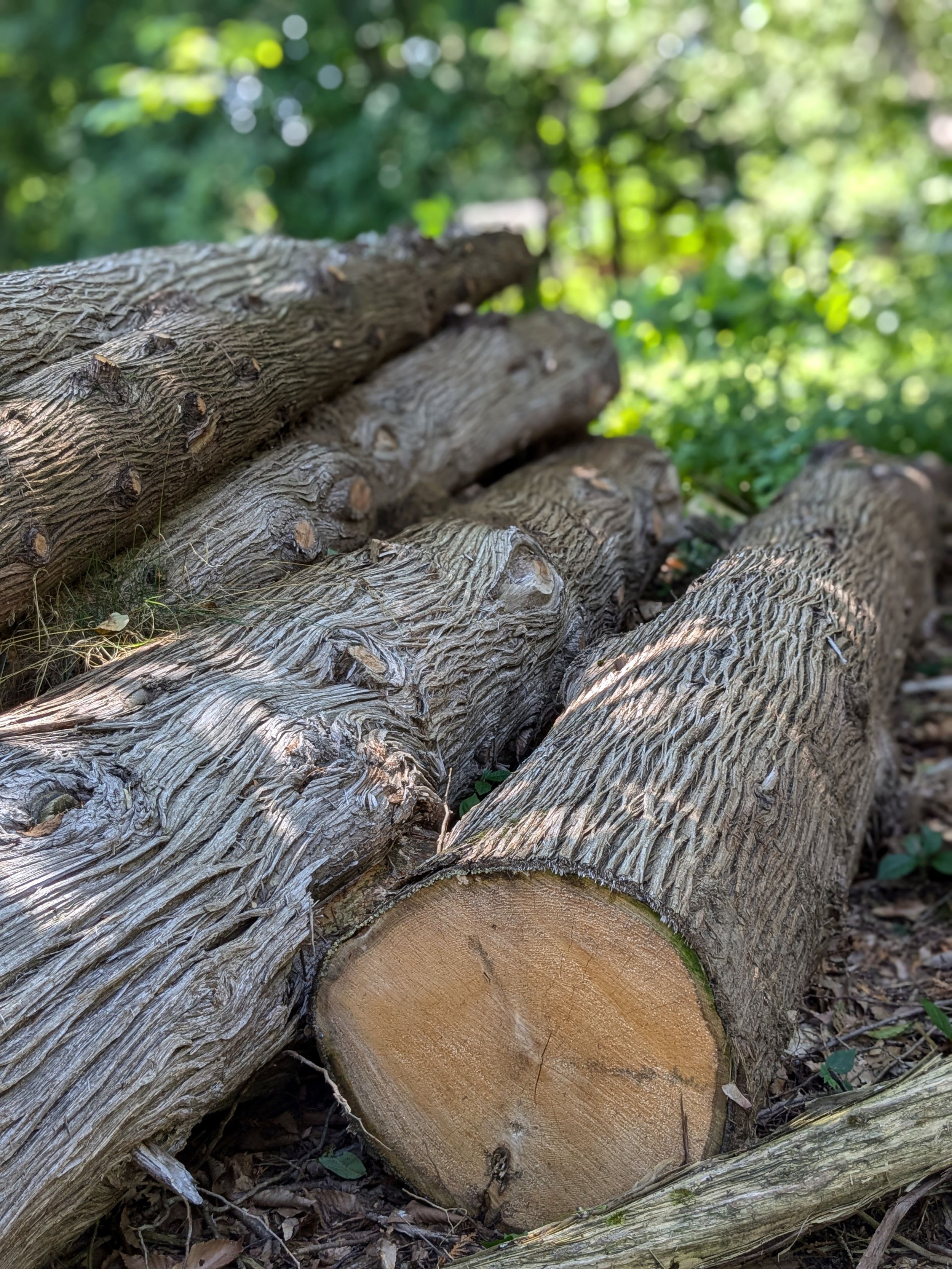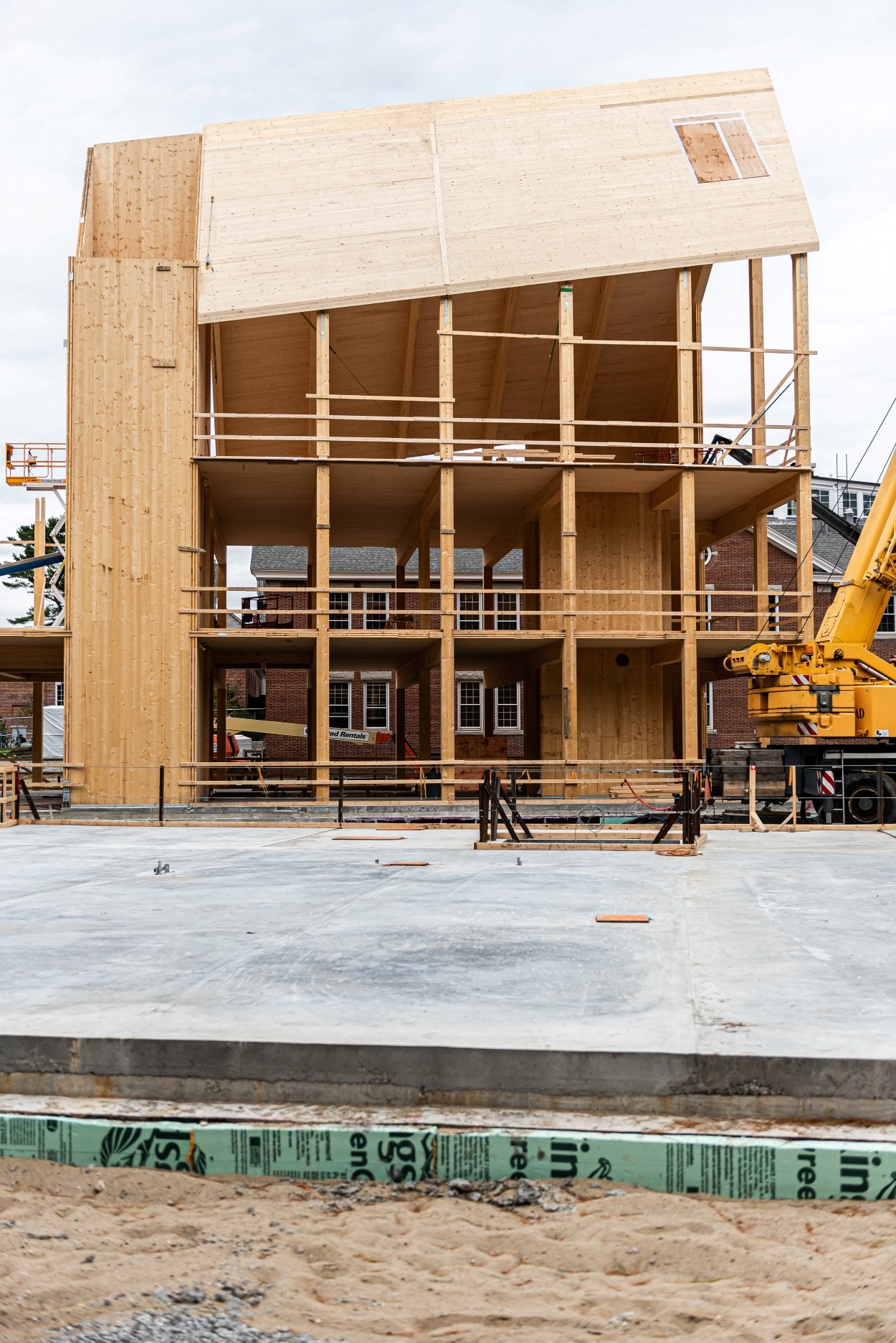Building with lumber harvested onsite
Ross Clair of Chesterville framed his house with hemlock milled from his property. COURTESY PHOTO
By Lee Burnett
BUILDING CONSTRUCTION was new to John Flood when he started farming five years ago, but it just felt right to build with timber cleared from his site.
“Everything you see is milled from the site,” says Flood, as he walks a visitor around Terra Firma, an organic sheep and chicken farm in Acton. All the buildings are clad in rough-sawn board and batten siding: two barns, an equipment shed, two chicken coops and a small house. Flood is certain he and his partner saved money by not buying lumber at retail prices, but he’s not sure how much. “I didn’t push a pencil, but it just made sense,” he says. “And now with the price of lumber, it makes a lot of sense.”
Organic sheep and chicken farmers John Flood and Dane Giallongo sheathed the farmhouse in the background with pine boards milled from their property in Acton. PHOTO: LEE BURNETT
Flood would receive no argument from the thousands of Maine farmers, loggers and do-it-yourselfers who own portable sawmills. Maine may, in fact, be a hotbed of portable sawmilling. Thomas Bandsaw Mills in Brooks is a home-grown manufacturer, and Wood-Mizer, one of the nation’s largest portable sawmill manufacturers, has located its New England distribution center in Maine.
But building with nearby trees isn’t always the smart thing to do, as I learned through a shed-building experience of my own. It was an island project, and my hunch was that a neighbor’s offer of free trees was too good to pass up. I still felt that way after felling the trees myself, dragging them to the site behind a car, lugging them up to our yard, squaring off some timbers with an ax and using most of the timber in the round. I did buy some building materials from a lumber yard, and while I was there, I smugly checked the price of two-by-fours—curious about exactly how much money I had saved—and was shocked at their affordability. I immediately felt a bit foolish about my project.
So, when does it make sense to build with your own timber? This article is an attempt to answer that question.
The benefits of building with onsite lumber
There are good reasons to build with onsite lumber. It’s satisfying in a self-sufficient way. It carries a low-carbon footprint since nearly all transportation emissions are avoided. And it’s affordable, although the money savings are much less than most people assume. I learned this from talking to builder Nick Zandstra of Knock-On-Wood SawWorks in Topsham, Vt. Zandstra has a good handle on costs because his company does it all: logging your trees, milling them onsite and building what you want.
“Many people think there are going to be huge cost savings because they have all these trees, but that’s not the case,” Zandstra says. It’s true that logging, extracting and milling lumber onsite cumulatively costs in the neighborhood of 44–55 cents a board foot, which is half or less than for comparable wood from a lumber yard, Zandstra says. But he notes that materials account for just 15–20% of the total cost of construction, considering roofing, subcontractors, labor and so forth. “You’re only saving 50% of 20%.” That works out to savings of approximately 10% on the total cost when you build with lumber harvested onsite.
Zandstra likes to point out that a more significant financial benefit is the improved value of your woodlot from culling trees. “That is often overlooked,” he says, noting that the remaining trees in your woodlot will grow faster and accumulate value for a later harvest. “It’s money in the bank.”
Portable sawmilling
Zandstra’s logging-milling-building business model is not replicated by anyone I know of in Maine. Just finding a portable sawmiller can be a challenge. Wood-Mizer has a “Find a Local Sawyer” feature on its website. But most of the 27 Maine sawyers listed won’t travel to your woodlot; they expect the logs to be brought to them. So, if you build with your own trees, expect significant logistical effort. It can mean finding and contracting with separate people for logging, trucking and sawing. And if you want the lumber kiln dried or planed, that’s even more effort.
To be sure, most woodlots can provide enough lumber for building. Constructing even a large barn involves only dozens of trees, not hundreds or thousands. Most woodlots can also supply sufficient quality. Typically, the lower tree trunk is milled into timbers and structural members, and the upper trunk with branches is milled into lesser-quality, knotty boards. Hemlock and pine are the best, but hardwoods are fine, although a higher use for hardwoods would be to sell them for flooring or furniture.
John Lambert and son Tim stay plenty busy sawing logs brought to their bandsaw mill in Wells that they no longer travel with their mill. PHOTO: LEE BURNETT
Addressing Concerns when building with green lumber
There are two things to be concerned about when building with “green lumber,” the common term for unplaned, non–kiln-dried lumber: structural strength and moisture content. Strength is obviously important, since you want your structure to withstand snow loads and heavy wind. Moisture content is also critical. Freshly cut wood is heavy with sap. If you use it right away in residential construction, the moisture can become trapped in your walls and grow mold, a serious health hazard. Furthermore, as wood dries out, it shrinks and may also twist, crack or do other unpredictable things that drive carpenters crazy.
You can avoid these problems if you buy lumber through retail channels. Retail lumber used in construction carries a grade stamp, certifying that both the strength and moisture content has already met minimum standards. (Controlled drying in a kiln brings moisture content down to no more than 19%; the strength is measured through an independently audited grading program.) If your wood does not come from the lumber yard, these issues are your responsibility to address.
Issues of moisture and strength are easily dealt with if you’re building a barn, garage or shed. The open character of these structures allows wood to dry in place, and the shrinkage factor is not a critical consideration. (Typically, lumber is air-dried onsite for months, which involves stacking wood in layers separated by spacers or “stickers” to allow for air flow.) Assurance of strength comes from the training of your builder, assuming they follow building codes on the load-bearing capacities of lumber in various dimensions.
Building a house with green lumber is a bigger challenge, particularly if you’re concerned with energy efficiency and building health. As mentioned earlier, insufficiently dry lumber can grow mold and cause serious health problems, a greater risk with the tight construction practices common today. Lumber that dries in place creates another issue for modern builders: shrinkage and air gaps that reduce the energy efficiency of the building. These problems can be avoided by air drying lumber for a year or more or by getting wood kiln dried, which adds logistical challenges and cost. (Kiln space is so scarce in Maine that it can take months to get a spot in a kiln to have lumber dried.)
Residential construction must also meet building code requirements, standards that agricultural buildings do not need to meet. Typically, this means using graded lumber or jumping through more hoops. (See Grading lumber below.)
Flood and his partner were fortunate to find a builder who owned a portable Wood-Mizer sawmill. They threaded the building-code needle by using green lumber to frame the outbuildings and graded lumber from the retail lumber yard to frame the house. They used both kinds of lumber framing for one of the barns, which is divided between sheep stables and workspace for farm employees.
“Half this barn is for agriculture, and the code enforcement officer said ‘fine,’” Flood explains, as he points to a partition wall dividing the two sections. “We had to meet code on the other side of the wall.”
Photo: Jared McCourt.
Grading lumber
MAINE’S STATEWIDE BUILDING CODE allows you to use onsite-sawn lumber in residential structures, but you will have to jump through some hoops to do so.
In most Maine communities, the local code officer will insist on seeing grade stamps on dimensional lumber, certifying its structural strength for use in framing. But that is for their own convenience. The native lumber provision in the state code specifically allows “non-graded lumber,” although it carries a caveat that “the materials must be of sufficient quality to be adequate for the purpose intended and must adhere to the provisions of these Codes.”
In other words, the burden is on you to demonstrate to the local code officer that your site-sawn lumber, also called green lumber, is appropriate for the intended use, according to Paul Demers, state building official in the Office of the State Fire Marshal. “If you can show me an equivalent, I will let you use it, if there is supporting documentation,” Demers says.
The 2015 Maine Uniform Building and Energy Code applies throughout the state, although enforcement is optional in communities with fewer than 4,000 residents. The code does not apply to agricultural buildings.
It’s not rocket science to grade lumber. New Hampshire allows portable sawmillers to self-certify their own lumber, as long as they complete a self-study guide on how to recognize #2 or better lumber, the minimum requirement for use in construction. But Maine requires lumber grading by a third party. Occasionally, this can be done by a local code officer who is trained and willing to inspect and certify rough-sawn lumber. But Demers cautions that you should not expect a code officer to have the training or inclination. Typically, the code officer will require someone else to inspect and certify the lumber. So called “on-demand” lumber graders are available through Northeast Lumber Manufacturers Association in Cumberland. Alternatively, some structural engineers are also trained to grade lumber.
In both cases, expect a long lead time and high fees. One structural engineering firm I checked with bills at $210 per hour plus mileage.
Most old homes in Maine were built with green lumber, and many old timers insist it can be done today without problems. Ross Clair, distributor of Wood-Mizer sawmills in Maine, built his 2,500-square-foot home in Chesterville with green lumber by sawing dimensional lumber twice, first at full dimension when the logs were freshly cut, then “sizing” it to nominal dimension after the lumber had air-dried for a few months. Once installed, the lumber dries even more before the house is enclosed.
“It’s very doable,” he says. “But you can get into trouble if you don’t know what you’re doing.”
He notes that Chesterville in Franklin County, population 1,400, is exempt from enforcing the state building codes. “If you go south,” he says, “you probably have to hire someone to grade your wood.”
This article appeared in the Fall 2022 edition of Green & Healthy Maine HOMES. Subscribe today!
Find Maine experts that specialize in healthy, efficient homes in the Green Homes Business Directory.























